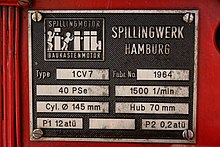Industrial labeling
Industrial labeling means the identification of locations, systems, machines and components that are used for industrial production. While product labeling addresses consumers or processing companies, industrial labeling acts as a central element of organization and orientation in the production process. It is a special case when a product label becomes an industrial label at the same time, for example when labeling machines in mechanical engineering.
Functions of industrial marking
The following functions are of central importance in industrial labeling: security, documentation of compliance with standards, manufacturer and performance verification (nameplate), traceability, identification, traceability and protection against plagiarism.
Types of marking
The marking is carried out as direct marking directly on the object to be marked, or as medium marking on different carrier materials (mostly metal, plastic or foil).
With direct marking, the marking is applied directly to machines, components and other objects to be marked without an intermediate medium. There are different techniques for doing this. In the case of medium labeling, however, a carrier medium is used that is first labeled - and then attached to the object to be labeled. Films, multilayer materials, metals and plastics are used as carrier media for industrially used labels.
The following forms of representation are mostly used:
- Plain text in letters and numbers (different languages)
- Symbols
- Barcode (1D code)
- 2D code
- RFID tags
Requirements for the license plate
Since many labels used in production processes are exposed to regular loads (high temperatures, chemical and physical stress), high resistance is one of the central requirements of industrial labels. Good legibility (especially of codes) is also one of the frequently asked requirements.
After all, a lot of the identification content is also required in a multi-colored representation, for example in the case of safety identification .
Manufacture of license plates
There are different manufacturing processes for industrial labels, which are divided into two broad areas.
The following methods are mostly used for direct labeling as direct marking of production equipment (machines, devices, boilers, pipes, etc.):
- Mechanical engraving
- Laser marking
- Needle / scratch markers
- Stamp
The following manufacturing processes are mainly used for medium identification in industrial identification:
- CO 2 laser (carbon dioxide laser )
- Anodizing vacuum process ( anodizing process )
- Fiber laser
- Crystal laser ( solid state laser )
- Mechanical engraving
- Needle and scratch markers
- PrintoLUX process
- screen printing
- Solvent printing (foil printing)
- Pen plotter (plotter)
- Thermal transfer printing (thermal printing)
- UV direct printing
literature
- Hermann Oberhollenzer (ed.), Manufacturing process for industrial labeling . Springer Verlag, Heidelberg 2018, 320 pages, ISBN 978-3-662-55331-2 , e-book https://www.springer.com/de/book/9783662553305 .
- Dieter Bäuerle, Laser - Basics and Applications in Photonics, Technology, Medicine and Art . Wiley-VCH, Weinheim 2013, 214 pages, ISBN 978-3527408030
Web links
- Online version of the textbook Manufacturing Processes for Industrial Identification, published in 2018 - A current overview and decision-making aid for plant and mechanical engineering
- Explanation of the Society for Electronics and Design mbH (GED) on current possibilities and on the functions of the circuit board marking
- Detailed information from the Karlsruhe Chamber of Commerce and Industry on the meaning of the CE mark as a "technical passport for certain product groups within the EU member states as well as Iceland, Liechtenstein and Norway"
Individual evidence
- ^ Annoying minor matter , in: VDMA Magazin, Verband Deutscher Maschinen- und Anlagenbau e. V., Frankfurt, issue 4/2019, April 2019.
- ↑ Hermann Oberhollenzer (Ed.), Manufacturing Processes for Industrial Identification , Springer, Heidelberg 2018, 320 pages, ISBN 978-3-662-55331-2
- ↑ No more hassle with replacement and re-signage , in: MM Logistik, Das Magazin für Industrie und Handel, Vogel Communications Group GmbH & Co. KG, Würzburg, Issue 2, March 25, 2019.
- ↑ Parallel effort does not have to be - when labeling in mechanical engineering, save effort and costs through coherence , in: Der Betriebsleiter, monthly magazine Vereinigte Fachverlage GmbH, Mainz, June 2019 edition.
